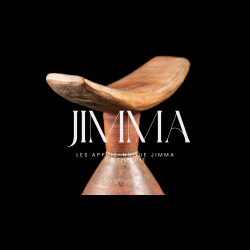
















Headrest Jimma (Ethiopia)
This ancient headrest from the Jimma region in southwestern Ethiopia belongs to a millennia-old African tradition in which a utilitarian object becomes a true cultural, social, and identity marker. Carved from a single piece of wood, it features a carefully balanced conical base topped with a gently curved platform, perfectly shaped to cradle the line of the jaw and neck.
A deeply personal object, the headrest accompanied its owner in everyday life as well as during moments of rest. From an ergonomic perspective, it allows for a natural alignment of the spine while keeping the head elevated. Its primary function, however, was also to protect elaborate hairstyles—true social constructions that could require several hours to create. These hairstyles were far more than aesthetic choices; they visually expressed age, rank, social status, gender, and sometimes community affiliation.
In Ethiopia, the intimate relationship between an individual and their headrest is reflected even in language. In Amharic, it is known as yagertera, literally “the pillow of my land,” while in Oromiffaa it is called boraatiz, meaning “tomorrow-you,” emphasizing the connection between rest, continuity, and the future. Even after their practical use ended, headrests retained the physical traces of their owners. Many examples display a deep, dark polish on the upper platform and sides, resulting from the wood’s absorption of traditional hair preparations based on butter (käbbe) and other vegetal substances used to shape and condition the hair.
While the earliest preserved African headrests come from ancient Egypt and date to the Second and Third Dynasties (circa 2649–2150 BCE), Ethiopian headrests reveal a striking continuity of form across time. In southern and central Ethiopia, the use of headrests is estimated to have begun two to three centuries ago. Among the most common forms are monolithic blocks, columnar headrests with curved platforms, and conical bases topped with a curved support, as seen in this particularly harmonious example.
Such headrests were widely used by semi-nomadic pastoral groups in the region, notably among the Oromo, Gurage, Sidaama, and neighboring peoples. The circulation of forms across Ethiopia, Kenya, Uganda, and South Sudan explains the remarkable stylistic diversity of these objects and the difficulty of assigning them rigidly to a single ethnic group. Each piece remains unique, shaped by the hand of the carver and the personal history of its owner.
Beyond its ethnographic significance, this Jimma headrest captivates through the purity of its lines, the elegance of its proportions, and the softness of its patina. It perfectly embodies the convergence of function, aesthetics, and symbolism that defines early African art.
Published in a major reference book that has had a lasting impact on the African art market and is associated with numerous international auction records, this headrest benefits from rare documentary prestige for an object of its kind. It represents an exceptional opportunity for collectors seeking a piece that is authentic, historically documented, and imbued with a quiet yet powerful presence.
An object of rest, memory, and identity, this Jimma headrest is far more than a functional artifact: it is a fragment of life, carried across time.

Headrest Jimma (Ethiopia)
This ancient headrest from the Jimma region in southwestern Ethiopia belongs to a millennia-old African tradition in which a utilitarian object becomes a true cultural, social, and identity marker. Carved from a single piece of wood, it features a carefully balanced conical base topped with a gently curved platform, perfectly shaped to cradle the line of the jaw and neck.
A deeply personal object, the headrest accompanied its owner in everyday life as well as during moments of rest. From an ergonomic perspective, it allows for a natural alignment of the spine while keeping the head elevated. Its primary function, however, was also to protect elaborate hairstyles—true social constructions that could require several hours to create. These hairstyles were far more than aesthetic choices; they visually expressed age, rank, social status, gender, and sometimes community affiliation.
In Ethiopia, the intimate relationship between an individual and their headrest is reflected even in language. In Amharic, it is known as yagertera, literally “the pillow of my land,” while in Oromiffaa it is called boraatiz, meaning “tomorrow-you,” emphasizing the connection between rest, continuity, and the future. Even after their practical use ended, headrests retained the physical traces of their owners. Many examples display a deep, dark polish on the upper platform and sides, resulting from the wood’s absorption of traditional hair preparations based on butter (käbbe) and other vegetal substances used to shape and condition the hair.
While the earliest preserved African headrests come from ancient Egypt and date to the Second and Third Dynasties (circa 2649–2150 BCE), Ethiopian headrests reveal a striking continuity of form across time. In southern and central Ethiopia, the use of headrests is estimated to have begun two to three centuries ago. Among the most common forms are monolithic blocks, columnar headrests with curved platforms, and conical bases topped with a curved support, as seen in this particularly harmonious example.
Such headrests were widely used by semi-nomadic pastoral groups in the region, notably among the Oromo, Gurage, Sidaama, and neighboring peoples. The circulation of forms across Ethiopia, Kenya, Uganda, and South Sudan explains the remarkable stylistic diversity of these objects and the difficulty of assigning them rigidly to a single ethnic group. Each piece remains unique, shaped by the hand of the carver and the personal history of its owner.
Beyond its ethnographic significance, this Jimma headrest captivates through the purity of its lines, the elegance of its proportions, and the softness of its patina. It perfectly embodies the convergence of function, aesthetics, and symbolism that defines early African art.
Published in a major reference book that has had a lasting impact on the African art market and is associated with numerous international auction records, this headrest benefits from rare documentary prestige for an object of its kind. It represents an exceptional opportunity for collectors seeking a piece that is authentic, historically documented, and imbued with a quiet yet powerful presence.
An object of rest, memory, and identity, this Jimma headrest is far more than a functional artifact: it is a fragment of life, carried across time.
